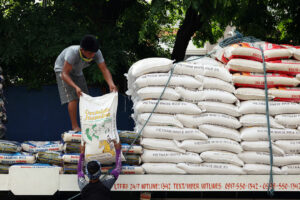THE Bureau of Customs (BoC) said revenue foregone in the second half due to the reduced rice tariffs is estimated at P16.34 billion.
In an e-mail to BusinessWorld, Customs Commissioner Bienvenido Y. Rubio said rice tariff collections in the six months to December will fall 57.45% to P12.1 billion under the new 15% tariff on imports of the staple grain.
“The BoC was projected to collect P28.447 billion using the (original) 35% tariff rate. Applying a 15% tariff rate reduces BoC collections to P12.103 billion… resulting in a decrease of P16.344 billion,” Mr. Rubio said.
In a bid to tame rice prices, President Ferdinand R. Marcos, Jr. slashed the tariff on rice imports to 15% from 35% until 2028 via Executive Order (EO) No. 62, which took effect on July 7.
In July, collections generated by imported rice dropped 27.9% to P889.13 million.
Had the government retained the 35% import tariff on rice, the BoC would have collected P2.15 billion that month, it said.
Meanwhile, Samahang Industriya ng Agrikultura Executive Director Jayson H. Cainglet said EO 62 has not succeeded in substantially lowering rice prices.
“As what we have pointed out from the outset, savings of importers from tariff reduction will not automatically translate to cheaper rice prices. Importers and traders are pocketing the savings from the tariff reduction,” he said via Viber.
At the end of October, the price of imported regular-milled rice rose 73 centavos month on month to P45.22 per kilogram, according to Agriculture department price monitors.
On the other hand, well-milled rice at the end of October fetched P48.93 per kilo, down 38 centavos from a month earlier.
Rice import tariffs are allocated to the Rice Competitiveness Enhancement Fund (RCEF) under Republic Act No. 11203 or the Rice Tariffication Law (RTL).
Under the law, P10 billion in tariff money is to be allocated to RCEF for six years to distribute machinery, seed, credit, and fertilizer to farmers. The RCEF expired in June, but the President is due to sign amendments to the law seeking to extend its term and expand its allocation.
The decline in rice tariffs would also mean fewer subsidies for rice farmers, who are anticipating the looming effects of the La Niña weather pattern on production, Mr. Cainglet said.
“We are yet to approach peak harvest, and there is concern that the farmgate price of palay will further drop. Worse, the rice industry has been receiving significantly less from the RCEF,” he said.
In a Viber message, Federation of Free Farmers National Manager Raul Q. Montemayor said the foregone tariffs would mean farmers would receive less budgetary support under the Rice Farmer Financial Assistance Program (RFFA), one of the initiatives funded by excess tariff collections.
Under the RTL, if annual tariff revenues exceed P10 billion, extra revenues would be earmarked for the RFFA, the Expanded Crop Insurance Program on Rice, titling of agricultural rice lands, and the Crop Diversification Program.
At the end of September, BoC collections rose 4.59% to P690.7 billion, about 0.46% short of its P693.9-billion target for the nine-month period.
Customs aims to collect P939.7 billion in revenue for 2024. — Beatriz Marie D. Cruz
